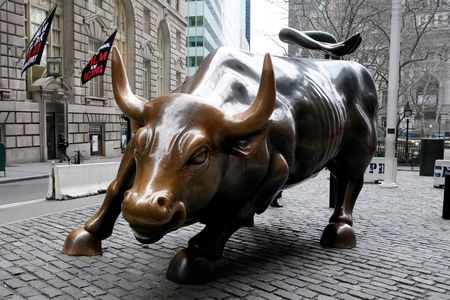By Lewis Krauskopf
NEW YORK (Reuters) – As inflation worries ease, U.S. stocks may need a fresh source of fuel to propel further gains this year, investors said.
Data released on Thursday showed annual inflation, which had been running at 40-year highs a year ago, rose at a more moderate pace than expected in July, supporting the so-called “Goldilocks” narrative of disinflation and resilient growth that has won over bearish investors and boosted risk assets this year. The S&P 500 has gained more than 16% on a year-to-date basis, though it was last trading largely flat on Thursday.
But with many traders now betting the Federal Reserve is unlikely to raise interest rates again this year and fears of a U.S. recession receding, an improving inflationary picture may become less of a driver for stock prices going forward.
That may make it more challenging for stocks to continue their recent rise, with high Treasury yields offering an attractive alternative, equity valuations stretched and investors’ stock exposure far higher than it had been at the beginning of the year.
The latest CPI report “is good news. At the same time, I think that the S&P is pretty fully valued,” said Jack Ablin, chief investment officer at Cresset Capital. “With stocks priced where they are, they are going to need a tailwind of lower rates to keep this momentum going.”
Indeed, stock moves have been more constrained on the CPI release dates in 2023 compared to last year, with the S&P 500 moving at least 1% in either direction just once so far this year, compared to six times in 2022, when it was far less clear how far prices would rise and how aggressively the U.S. central bank would respond.
Individual CPI reports have not had “a material and lasting impact” on markets for several months, said Guy LeBas, chief fixed income strategist at Janney Montgomery Scott.
“I suspect that’s because, very simply, the crisis period of inflation is over and really has been for a few months,” LeBas said.
Some investors also said the July CPI report, while encouraging, was not enough to take more Fed rate hikes decisively off the table. Traders of futures tied to the Fed’s policy rate saw less than a 10% chance the central bank will lift that rate from the current 5.25%-5.50% range at its Sept. 19-20 policy meeting, according to CME Group’s FedWatch Tool.
However, another CPI report is due to be released before that meeting. The Fed’s annual economic policy gathering in Jackson Hole, Wyoming later this month also could influence markets.
The CPI report is “obviously positive for the markets,” said Paul Nolte, senior wealth advisor and market strategist for Murphy & Sylvest Wealth Management. “But I think when you look at the overall picture, it still keeps the Fed engaged,” he said, noting that the latest annual inflation rate of 3.2% remained above the Fed’s 2% target.
END OF RELIEF RALLY?
Meanwhile, with the S&P 500 about 2.5% off the year-to-date high it hit last month, investors have cast a wary eye on the market’s stretched valuations. The index’s forward price-to-earnings ratio has risen to 19 times, well above its long-term average of 15.6 times, according to Refinitiv Datastream.
That reduces the attractiveness of stocks compared to bonds, with the benchmark 10-year US Treasury note yielding more than 4.00% and six-month Treasuries offering about 5.5%. The equity risk premium, which compares the attractiveness of stocks over risk-free government bonds, has been shrinking for most of 2023 and was around its lowest levels in well over a decade this week.
At the same time, stocks will have to contend with what has historically been a challenging calendar period for equities. The month of August has delivered on average the third-lowest return for the S&P 500 since 1945, with September ranking as the lowest, according to CFRA Research.
Stifel equity strategist Barry Bannister is among those who expect the U.S. stock market will be hard-pressed to climb from its current levels. In a note on Wednesday, he said the S&P 500 would likely “trade sideways” in the second half of the year and end 2023 at 4,400 points, which was about 1.5% below Wednesday’s closing level.
“We believe the relief rally that was predicated on ‘no recession in 2023’ is now over,” Bannister wrote.
(Reporting by Lewis Krauskopf; additional reporting by Karen Brettell; Editing by Ira Iosebashvili and Paul Simao)





